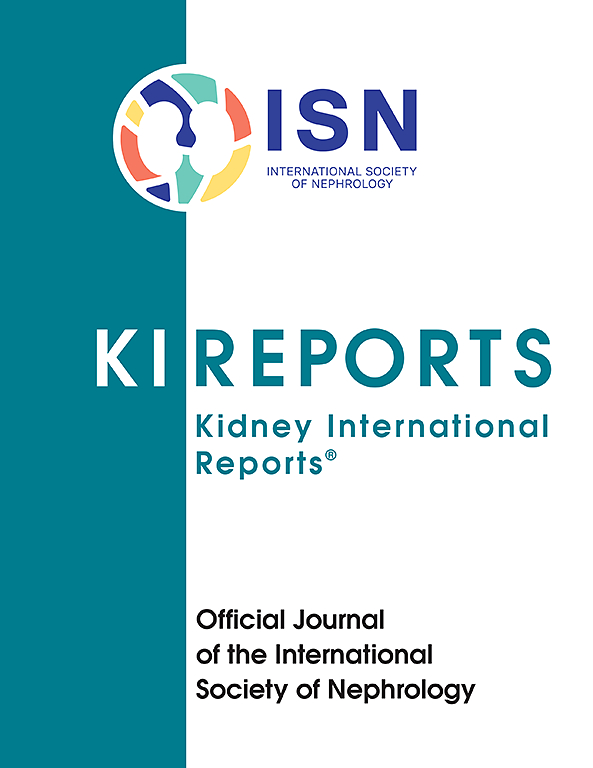SARS-CoV-2 蛋白沉积会增强肾脏补体激活,加重 COVID-19 后膜性肾病的肾损伤
IF 5.7
2区 医学
Q1 UROLOGY & NEPHROLOGY
引用次数: 0
摘要
据报道,COVID-19 与膜性肾病(MN)的发生和复发有关。COVID-19 后 MN 的临床病理特征和补体系统激活情况尚不清楚。本研究共纳入了 38 例经活检证实的 MN 患者,这些患者在 COVID-19 后出现了新发蛋白尿。100 名在 COVID-19 大流行之前确诊的原发性 MN 患者为对照组。对 38 例 COVID-19 后的 MN 患者的肾脏进行了 SARS-CoV-2 核壳蛋白免疫组化染色。通过酶联免疫吸附试验检测血清膜攻击复合物(MAC)。免疫组化法检测了肾小球不同途径的补体蛋白染色。38 名患者中有 13 人的 SARS-CoV-2 核壳蛋白染色呈阳性。与对照组患者相比,COVID-19 患者的临床表现更为严重。与 SARS-CoV-2 染色阴性的患者相比,SARS-CoV-2 染色阳性的患者肾病综合征比例更高,血清白蛋白水平更低,肾间质纤维化程度更严重。COVID-19 后 MN 的血清 MAC 水平和肾脏 MAC 染色强度明显高于对照组患者。SARS-CoV-2染色阳性的MN患者的MAC表达强于SARS-CoV-2染色阴性的对照组患者和COVID-19后的MN患者。因子 H 的表达趋势与 MAC 的表达趋势一致。补体系统的过度激活加重了 COVID-19 后 MN 的症状。可能需要考虑针对补体系统的治疗策略。本文章由计算机程序翻译,如有差异,请以英文原文为准。

SARS-CoV-2 Protein Deposition Enhances Renal Complement Activation and Aggravates Kidney Injury in Membranous Nephropathy After COVID-19
Introduction
COVID-19 has been reported to be associated with the occurrence and recurrence of membranous nephropathy (MN). The clinicopathological characteristics and complement system activation of MN after COVID-19 are unclear.
Methods
A total of 38 patients with biopsy-proven MN who developed new-onset proteinuria after COVID-19 were enrolled in this study. One hundred patients with primary MN diagnosed before the COVID-19 pandemic were the control. Renal immunohistochemical staining for SARS-CoV-2 nucleocapsid protein was performed in 38 patients with MN after COVID-19. Serum membrane attack complex (MAC) was detected by enzyme-linked immunosorbent assay. Glomerular staining for the complement proteins in different pathways were detected by immunohistochemistry.
Results
Thirteen of 38 patients had positive staining for SARS-CoV-2 nucleocapsid protein. Compared with the control patients, the clinical manifestations were more severe in patients after COVID-19. Patients with positive SARS-CoV-2 staining had a higher proportion of nephrotic syndrome, lower level of serum albumin, and greater severity of renal interstitial fibrosis than those of patients with negative SARS-CoV-2 staining. Serum MAC level and renal MAC staining intensity of MN after COVID-19 were significantly higher than those of the control patients. MAC expression in MN patients with positive SARS-CoV-2 staining was stronger than that in both control patients and MN after COVID-19 with negative SARS-CoV-2 staining. The expression trend of factor H was consistent with that of MAC.
Conclusion
Excessive activation of the complement system aggravated symptoms in MN after COVID-19. Therapeutic strategy targeting the complement system may need to be considered.
求助全文
通过发布文献求助,成功后即可免费获取论文全文。
去求助
来源期刊

Kidney International Reports
Medicine-Nephrology
CiteScore
7.70
自引率
3.30%
发文量
1578
审稿时长
8 weeks
期刊介绍:
Kidney International Reports, an official journal of the International Society of Nephrology, is a peer-reviewed, open access journal devoted to the publication of leading research and developments related to kidney disease. With the primary aim of contributing to improved care of patients with kidney disease, the journal will publish original clinical and select translational articles and educational content related to the pathogenesis, evaluation and management of acute and chronic kidney disease, end stage renal disease (including transplantation), acid-base, fluid and electrolyte disturbances and hypertension. Of particular interest are submissions related to clinical trials, epidemiology, systematic reviews (including meta-analyses) and outcomes research. The journal will also provide a platform for wider dissemination of national and regional guidelines as well as consensus meeting reports.
 求助内容:
求助内容: 应助结果提醒方式:
应助结果提醒方式:


